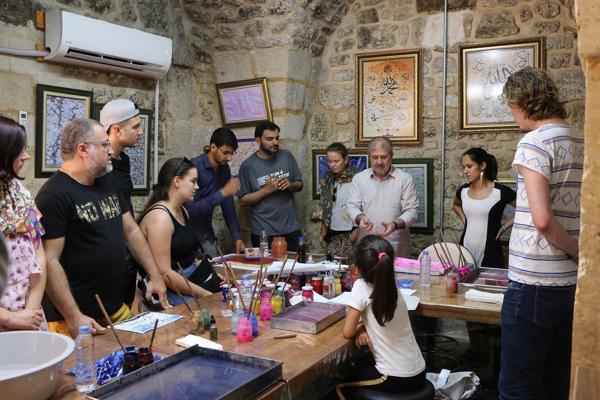Traditional arts alive on Şanlıurfa street
ŞANLIURFA - Demirören News Agency


A street in Şanlıurfa, where historical stone houses have been restored and turned into workshops, has become a popular spot for local and foreign tourists visiting the historical southeastern city. The workshops on mosaic, wood carving and silver processing attract the attention of visitors in the street where colorful images emerge.
Sanat (Art) Street was created by restoring the old houses in the historical Beykapısı Bedendibi walls with the “Nahit Stone” (Urfa stone) in the city, where the most beautiful examples of craftsmanship in Anatolia are found.
Since its inception, workshops have been organized for all art lovers in many fields such as bağlama, violin, painting, children’s choir, theater, photography, calligraphy, guitar, ney, mosaic, wood carving and silver processing.
Visitors to the historical streets and workshops take lots of photos. On the other hand, the trainees who come to the workshops on Sanat Street are educated in a profession, while also keeping the professions that are almost forgotten alive.
Ömer Sabuncu, a professional of the traditional Turkish art ebru (painting on water), is happy with the interest shown in the street.
“I’ve been involved in this art for 20 years, and after coming to Şanlıurfa, we have seen great interest,” he said.
“Our aim in art is to make good use of our people’s free time and to transfer this art to future generations. Again, thanks to Sanat Street, we want to contribute to the socio-cultural change in Şanlıurfa. We are happy to see the big changes in this neighborhood with the courses opened here,” he added.
Nuray Savaşlı said that she has been involved in illumination art for the last seven years and is happy to see more people visiting Sanat Street.
“Illumination is an art of decoration,” she said.“Earlier manuscripts of the Holy Quran were adorned with this art. However, nowadays, the writing edge is decorated because there are no more handwritten versions. Most of these decorations are made with 22-carat gold.”
Savaşlı said she produces art while also teaching the profession.
“There is intense interest in the courses we have opened here in order to keep this art, which is among the vanishing professions, alive,” she added.
“But it is very difficult to learn this art that requires patience, and the number of students drop after the courses start. However, the local and foreign tourists who come here to these works of ours make us forget all our tiredness.”
Calligraphy artists Mustafa Kaçar said the interest shown in the studios and courses encourage the artists.
“Calligraphy is a very difficult art,” he said. “It is an art that requires patience and continuity. Calligraphy is an art that progresses patiently. Our trainees, who show great interest in these courses, come with great enthusiasm, but unfortunately, they give up after spending a very short time in these workshops. It is very difficult to learn this art if the dialogue with the teacher is interrupted. Those who fall in love with calligraphy both relax and earn extra income.”
